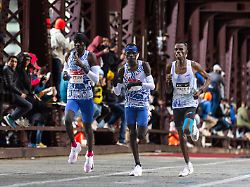Why do marathon records fall?
“Sexy” miracle shoes reinforce doubts about mythical times
November 4th, 2023, 10:50 a.m
A world record in Berlin, one in Chicago – the rapid development of running times is fascinating. How many shoes and how many people are involved in the marathon top times? Sometimes there are doubts. And then there is a list of banned doping offenders.
When the marathon stars set off on the legendary 42.195 kilometers in New York this Sunday, their eyes will inevitably be drawn to their shoes. Since Kenyan Kelvin Kiptum’s world records in Chicago a month ago and Ethiopian Tigist Assefa’s in Berlin in September, there has been more debate than ever about the high-tech material on their feet. It seems to be only a matter of time before the world record breaks the two-hour mark. The Kenyan Eliud Kipchoge was that fast four years ago – but this time, achieved practically under laboratory conditions with the help of countless pacemakers, is not considered a world record.
“The hype about the so-called super shoes has not only been around in the last few weeks,” says Wolfgang Potthast, who heads the clinical and technological biomechanics department at the Sports University in Cologne. With appropriate shoes, the oxygen intake of very well-trained amateur runners can be reduced by four percent. “This means that the muscles require four percent less energy and therefore run more economically. In other words, they can run four percent faster using the same amount of energy,” says the expert.
Above all, Nike and Adidas are in a race for the miracle shoes in the billion-dollar running shoe business; it is always a duel between the sporting goods giants. “We have known for several decades that reducing the weight of a shoe by 100 grams reduces oxygen uptake by 1 percent,” says Potthast. The combination of weight, a light cushioning foam and a carbon plate optimizes the shoe.
Just not at the Olympics or World Championships
“Theoretically, it doesn’t necessarily have to be carbon. But carbon is super light and has good stiffness properties. The idea behind the use is based on the sprint prostheses that Paralympics winners Oscar Pistorius and Markus Rehm started with,” says Potthast. “Also, carbon is fashionable right now, carbon is sexy and anything with carbon is cool.”
The international association World Athletics founded a working group on the increasingly exciting topic of shoes in the summer of 2020. The association then decided that in principle every shoe should have been commercially available to every athlete before it could be worn in a competition.
The exception to this are so-called prototypes that manufacturers make available to their sponsored athletes in competitions. According to the association, this period is limited to twelve months; these shoes cannot be worn at world championships and the Olympics. There are also certain requirements for the shoe structure. When developing the new shoes within the framework of the extensive set of regulations, one manufacturer says it relies on experts from the fields of biomechanics, coaching, design, engineering, material development, nutrition and sports psychology and physiology.
The shocking doping list
The rapid development of running times also raises questions beyond training performance and material. “There are two ways of looking at it. One is based on the development of shoe technology with the installation of the carbon plate. With this, the runners say, they run two minutes faster because the shoe has a certain spring effect,” said Jo Schindler, race director of the Frankfurter Marathons, the “Frankfurter Allgemeine Zeitung”.
“The other aspect is that whenever phenomenal achievements occur, in sport today you have to ask yourself whether everything was clean. I don’t want to accuse anyone of anything bad. I have no concerns about the recent world records, because they “The good history of the runners can be traced. The world records didn’t just come out of nowhere,” explained Schindler.
What is worrying, however, is that the running nation of Kenya is not only churning out records, but as of October 1st, it also has a top spot on the list of the world association’s “Athletics Integrity Unit” with more than 60 banned doping offenders – mostly long-distance runners takes. More and more African talent is focusing on half marathons and marathons because you earn more money on the road than on the track.
Shoes not suitable for every runner
What is undisputed is that the super shoes are fueling the flood of records, although there are several variables on the way to top times. “It’s important to me that the focus is on the athlete. The athlete delivers the performance, it doesn’t come from the shoes. Sure, four percent can make a big difference. But records will never fall just because of the shoes,” says Potthast. Performance in other endurance sports, such as cycling, is also getting better and better – “and cyclists don’t wear running shoes.”
For the world athletics association World Athletics (WA), the numerous records are not an unusual phenomenon. “Throughout our sport’s history, world records have always been set using the best technology available and today is no different,” WA said. Apart from technology, improved training techniques, more competitions, refined career paths or a more sophisticated diet are other reasons for record improvements.
The vast majority of hobby runners can save 250 to 500 euros for new super shoes anyway. Because they are designed for top athletes and not for average joggers. “It is certain that such shoes are not suitable for all runners. You don’t have to be as fast as Eliud Kipchoge, but you do have to be very fast. With the higher speed you have a different position of your body over your foot, for an Otto “It feels rather strange to normal consumers,” says Potthast.
